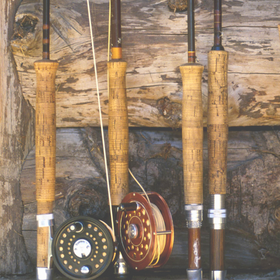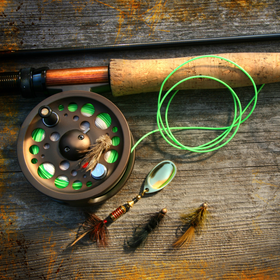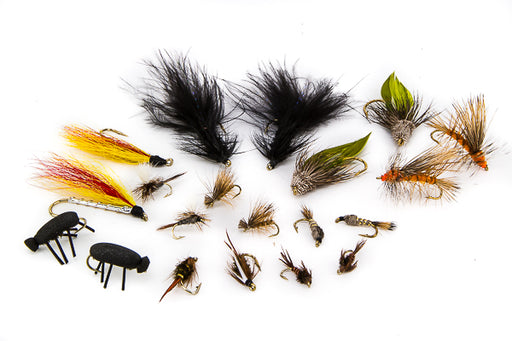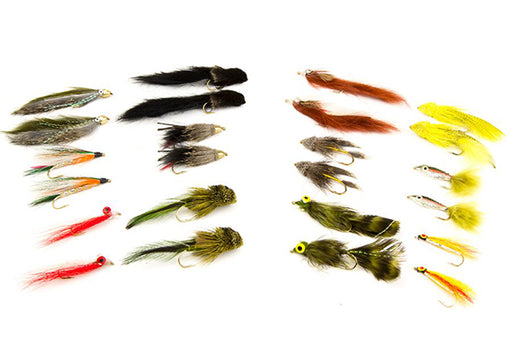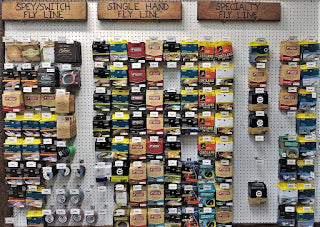
How to Read a Fly Line Box and Rod Labels
The following should help anglers understand what is in the box when they see a fly line at the shop or online, as well as how to interpret the numbers on a fly rod.

A couple of Douglas 9' 5wt rods
The first thing to know if the weight of the rod that you need to match a line to. The most common trout rod is a #5 or 5 weight rod. We shorten it to read "5wt".
The rod will likely have a series of numbers on it like "590-4" or something similar. The 5 is for the weight of the matching line, the 90 is for the length, as in 9'0" and the -4 stands for 4 pieces.
This is not universal across the industry, some companies list a 9'0" 5wt as a 905, and there is at least one that lists their rods by inches. Luckily, most rods now have a model number (like 590-4) as well as the length/weight/pieces listed separately.

890-4 - 9'0" 8wt 4 piece
It is important to match the line to the rod. It is like matching tires to your car. There are some different options for tread, style and a little variation on size, but if you buy tires that do not match the intended vehicle, there are going to be issues. Anglers in the past would upsize or downsize a line to match conditions, but that was when there were few options for line designs. Back in the day... fly lines all pretty much looked the same, but had different weights. Not so much today. There are specialized lines for all sorts of situations, rod types, casting styles, temperatures, and different fly types. It is generally better to a line that matches what you want to do than to use a mismatched line to achieve a different purpose than it was intended.
What's in that Fly Line Box?:
There are only so many ways that the weight in a fly line can be distributed. All fly lines will have a weighted "head" as well as a front and rear taper where the line changes from a large diameter to a small diameter. Where the weight is distributed is what makes a line do what it was made to do. The amount of weight determines what rod it is matched to.
Here are the configurations for typical fly lines:

Double Taper 3wt Floating
Full Floating - this type of line is the most popular type for trout fishing and many other types of popular fly fishing species like bonefish, tarpon, bass, carp, and salmon. The line floats due to air inside of it as well as the buoyant materials that it is constructed from. The box for a floating line will always have that F at the end, like WF5F or DT5F. Most trout fishing in rivers and streams is done with a floating line, and it is the line that nearly all fly anglers start off with.
Fly line boxes will also typically have the line color (or colors) listed on the box, as well as the overall length of the line.

Weight Forward 4wt Floating
Double taper - This line has weight distributed equally across the entire length of the line with equal tapers on both the front and rear end. Advantages include accuracy, line control and durability/value, as you can turn the line around when the front end starts to wear out and use it from the back end. Double taper lines are (almost) always floating instead of sinking.
Disadvantages of double tapers include poor distance, as well as having to make a few more false casts to get the line where it needs to go. A third disadvantage is that there are not many choices for design. The weight is distributed evenly, so it can't really be moved around for specialty purposes like with weight forward lines. These are typically dry-fly friendly lines that don't do well with other fishing styles. A typical double taper fly line box will say DT5F. This means Double Taper 5wt Floating. A Double Taper 3wt Floating line will say DT3F.
Weight Forward - This is by far the most common type of floating fly line, and all sinking/sink tip lines are weight forward. These lines have weight spread across the front section of line, with a long, thin section of "running line" in the back. Because the weight is not spread equally along the line, there are many different ways the weight can be distributed, leading to specialty lines for very niche purposes. A 5wt weight-forward floating line will have a box that says WF5F for Weight Forward 5wt Floating.

Double taper - This line has weight distributed equally across the entire length of the line with equal tapers on both the front and rear end. Advantages include accuracy, line control and durability/value, as you can turn the line around when the front end starts to wear out and use it from the back end. Double taper lines are (almost) always floating instead of sinking.
Disadvantages of double tapers include poor distance, as well as having to make a few more false casts to get the line where it needs to go. A third disadvantage is that there are not many choices for design. The weight is distributed evenly, so it can't really be moved around for specialty purposes like with weight forward lines. These are typically dry-fly friendly lines that don't do well with other fishing styles. A typical double taper fly line box will say DT5F. This means Double Taper 5wt Floating. A Double Taper 3wt Floating line will say DT3F.
Weight Forward - This is by far the most common type of floating fly line, and all sinking/sink tip lines are weight forward. These lines have weight spread across the front section of line, with a long, thin section of "running line" in the back. Because the weight is not spread equally along the line, there are many different ways the weight can be distributed, leading to specialty lines for very niche purposes. A 5wt weight-forward floating line will have a box that says WF5F for Weight Forward 5wt Floating.

This is part of a head system
Head System - The "head" or weighted section of fly line is separate from the running line. Most spey/switch setups use head systems, but it is uncommon elsewhere beyond a few Striped Bass anglers or really specialty situations. Heads are usually listed in grain weights. Grains are a unit of measuring mass. There are 13.4 grains to a gram if you want to get your scale out and weigh some lines.
The box for a head will list the grain weight, length and color, as well as the name. Spey/switch systems can include several components and can be complicated. If you are getting into two-handed fishing, learning what grain weights and line styles fit your rod and fishing style is important, but won't be covered here.

Head System - The "head" or weighted section of fly line is separate from the running line. Most spey/switch setups use head systems, but it is uncommon elsewhere beyond a few Striped Bass anglers or really specialty situations. Heads are usually listed in grain weights. Grains are a unit of measuring mass. There are 13.4 grains to a gram if you want to get your scale out and weigh some lines.
The box for a head will list the grain weight, length and color, as well as the name. Spey/switch systems can include several components and can be complicated. If you are getting into two-handed fishing, learning what grain weights and line styles fit your rod and fishing style is important, but won't be covered here.

A head and Versi-tip system
Versi-Tip Systems - These are sometimes called multi-tip lines. The exact configuration may vary, but they are a weight forward line or head system with interchangeable tips on the front of the line. These include sink tips of differing sink rates (including a floating tip) or possibly tips of different lengths.
A Versi-tip system for trout rods are increasingly rare. They are used primarily on spey/switch setups for two-handed rods today, but were quite popular in the 1990's and early 2000's for 9' trout rods.
While a floating line can have a few different configurations, there are other options for fly lines including sinking lines and sink tip fly lines.
Versi-Tip Systems - These are sometimes called multi-tip lines. The exact configuration may vary, but they are a weight forward line or head system with interchangeable tips on the front of the line. These include sink tips of differing sink rates (including a floating tip) or possibly tips of different lengths.
A Versi-tip system for trout rods are increasingly rare. They are used primarily on spey/switch setups for two-handed rods today, but were quite popular in the 1990's and early 2000's for 9' trout rods.
While a floating line can have a few different configurations, there are other options for fly lines including sinking lines and sink tip fly lines.

Intermediate Sinking Line
Sinking Lines
There are two types of sinking lines; full sinking and sink-tip. Both have their usefulness and proper place in the lineup.
Full Sinking Lines - These lines sink from front to back, but not always evenly. The tip sections often sink slightly faster than the rest of the line, so there is a more direct path from the fly to the angler. This is called density compensation (or some other proprietary name) and is featured in most sinking lines.

7wt Type V Sinking Line
Sink rate are usually measured in "types". A type II (usually with the roman numerals), more commonly called an "intermediate" sink rate, sinks about 1-2 inches per second. This is the most popular type of sinking line for trout fishermen, although the type III is also very common. A type III sinks at 3-4 inches per second. Type IV and Type V lines are also popular, but sinking lines that are more dense than Type V are harder to cast, hard to control and are not as popular.
Boxes will have configurations like this: WF5I for Weight Forward 5wt Intermediate.
A type III will say WF5S3 for Weight Forward 5wt Sink 3.

Sink rate are usually measured in "types". A type II (usually with the roman numerals), more commonly called an "intermediate" sink rate, sinks about 1-2 inches per second. This is the most popular type of sinking line for trout fishermen, although the type III is also very common. A type III sinks at 3-4 inches per second. Type IV and Type V lines are also popular, but sinking lines that are more dense than Type V are harder to cast, hard to control and are not as popular.
Boxes will have configurations like this: WF5I for Weight Forward 5wt Intermediate.
A type III will say WF5S3 for Weight Forward 5wt Sink 3.

7wt Sink Tip - Type III
Sink Tip lines - These lines have a section of sinking material at the front, followed by a floating section. Sometimes, the entire head sinks while other lines only have a small tip section that sinks. Sink sections can vary from 5' to 25' or longer for different fishing styles and situations. These are most commonly used in streams and rivers by anglers that are casting streamer flies. The floating portion on the back allows anglers to mend and control the line easier in a river than with a full sinking line. A sink-tip line will have a box that says something like: WF6F/S3, which stands for: Weight Forward 6wt Floating/Sink 3, as in it has both floating and sinking portions.

Sink Tip lines - These lines have a section of sinking material at the front, followed by a floating section. Sometimes, the entire head sinks while other lines only have a small tip section that sinks. Sink sections can vary from 5' to 25' or longer for different fishing styles and situations. These are most commonly used in streams and rivers by anglers that are casting streamer flies. The floating portion on the back allows anglers to mend and control the line easier in a river than with a full sinking line. A sink-tip line will have a box that says something like: WF6F/S3, which stands for: Weight Forward 6wt Floating/Sink 3, as in it has both floating and sinking portions.

A multi-density sinking line for a 10wt
Other types of sinking lines are a sort of hybrid. These are called multi-density sinking lines. They have lighter sink rates listed for the rear part of the line. The configurations on a box say something like WF6I/S3/S5. This would mean Weight Forward 6wt Intermediate/Sink 3/Sink 5. This means that the back part of the line has an intermediate sink rate, which transitions to a type III in the middle and then a type V sink in the front. These are relatively new, and are gaining in popularity.
There are other types of fly lines and tips that are highly specialized, including Euro nymph lines, which are often listed by their diameter. Some are a level diameter all the way through, while others are a double-taper configuration. Most are floating, but not all. Some have the core material listed, while others don't. That is a topic for another day...

Other types of sinking lines are a sort of hybrid. These are called multi-density sinking lines. They have lighter sink rates listed for the rear part of the line. The configurations on a box say something like WF6I/S3/S5. This would mean Weight Forward 6wt Intermediate/Sink 3/Sink 5. This means that the back part of the line has an intermediate sink rate, which transitions to a type III in the middle and then a type V sink in the front. These are relatively new, and are gaining in popularity.
There are other types of fly lines and tips that are highly specialized, including Euro nymph lines, which are often listed by their diameter. Some are a level diameter all the way through, while others are a double-taper configuration. Most are floating, but not all. Some have the core material listed, while others don't. That is a topic for another day...

Double Taper Euro Line .022" diameter
As always, we hope this helps to clarify any confusion that anglers may have towards understanding how to interpret what is in the box. Fly fishing can be overly complicated at times, but we are here to help you navigate all of the options and get the right stuff that will help you catch fish, and have a great time doing it!
 Andrew Perrault
Andrew Perrault
-Fishing, usually not catching
As always, we hope this helps to clarify any confusion that anglers may have towards understanding how to interpret what is in the box. Fly fishing can be overly complicated at times, but we are here to help you navigate all of the options and get the right stuff that will help you catch fish, and have a great time doing it!

-Fishing, usually not catching



